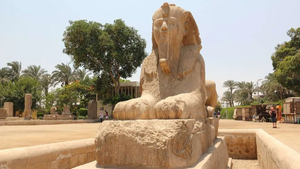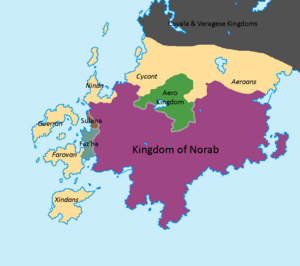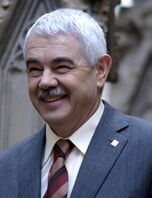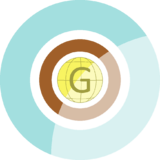Paqueonia: Difference between revisions
Philimania (talk | contribs) mNo edit summary |
Philimania (talk | contribs) mNo edit summary |
||
| Line 21: | Line 21: | ||
|largest_city = [[Hidalgo]] | |largest_city = [[Hidalgo]] | ||
|official_languages = [[Hestandan language|Hestandan]] | |official_languages = [[Hestandan language|Hestandan]] | ||
|ethnic_groups = 89.6% [[Hestando people| | |ethnic_groups = 89.6% [[Hestando people|Hestandan]]<br>8.9% [[Cavalan people|Cavalan]]<br>1.5% Others | ||
|ethnic_groups_year = 2000 | |ethnic_groups_year = 2000 | ||
|religion = 47.5% [[Hafan]]<br>41.8% [[Terranity]]<br>5.2% {{wp|Atheism|No religion}}<br>5.5 Others | |religion = 47.5% [[Hafan]]<br>41.8% [[Terranity]]<br>5.2% {{wp|Atheism|No religion}}<br>5.5 Others | ||
| Line 113: | Line 113: | ||
After the [[2nd Zestoric War]] ended in 1 CE, Pylosan colonies especially those on the [[Hesterlon Peninsula]] were assimilated into the [[Alarican Empire]]. However, Alarican control over the region suffered a setback in 3 CE when a rebellion began in the south. The [[Farovan]]s of Paloa and remnants of the Pylosan army under the leadership of [[Glycon]], a former Pylosan general, fought for control over the southern peninsula, forming a successful alliance with the Norravans and Aossans. Alarico sent numerous legions and its best generals to the region to quell the rebellion, in 10 CE, Glycon was killed at the [[Battle of Aima Hill]] near [[Tavares]] resulting in a power struggle among Glycon's allies allowing Alarico to put an end to the rebellion in 11 CE. Following multiple conquests and campaigns during the 1st century and early 2nd century, Alarico was able to assimilate the rest of the Hesterlon Peninsula after destroying a united [[Cycont]] army at the [[Battle of Arouthinium]] in 129. | After the [[2nd Zestoric War]] ended in 1 CE, Pylosan colonies especially those on the [[Hesterlon Peninsula]] were assimilated into the [[Alarican Empire]]. However, Alarican control over the region suffered a setback in 3 CE when a rebellion began in the south. The [[Farovan]]s of Paloa and remnants of the Pylosan army under the leadership of [[Glycon]], a former Pylosan general, fought for control over the southern peninsula, forming a successful alliance with the Norravans and Aossans. Alarico sent numerous legions and its best generals to the region to quell the rebellion, in 10 CE, Glycon was killed at the [[Battle of Aima Hill]] near [[Tavares]] resulting in a power struggle among Glycon's allies allowing Alarico to put an end to the rebellion in 11 CE. Following multiple conquests and campaigns during the 1st century and early 2nd century, Alarico was able to assimilate the rest of the Hesterlon Peninsula after destroying a united [[Cycont]] army at the [[Battle of Arouthinium]] in 129. | ||
=== Alarican rule === | === Alarican rule and Early Middle Era === | ||
' | A colonial regime was installed in what is now Paqueonia and Paloa soon after the defeat of the Cycont army in 129. They retained control of it for over four centuries. Alarican rule was bound together by law, language, and the Alarican roads. The cultures of the pre-Alarican populations were gradually [[Alaricanisation of the Hesterlon Peninsula|Alaricanised]] at different rates depending on what part of the peninsula they lived in, with local leaders being admitted into the Alarican aristocratic class. [[Hestorlia]] served as a granary for the Alarican market, and its harbours exported {{wp|gold}}, {{wp|wool}}, {{wp|olive oil}}, and {{wp|wine}}. [[Hafan]]ism was introduced during the mid 2nd century CE and became popular in the cities during the 3rd century. Most of Paqueonia's present languages and religion, and the basis of its laws, originate from this period. | ||
During the late 5th century CE, rebellions became more frequent in the region. According to the Contemporary historian [[Oppius]], following a successful rebellion which occurred in Paloa c. 466, the [[Hestando people]] [[470 Hestandan Rebellion|rebelled against Alarico]] in 470 CE eventually uprooting the colonial regime over Paqueonia in 479 after the [[Siege of Heithalka]] ended in a rebellion victory. | |||
[[File:Norab.png|thumb|The Hesterlon Peninsula {{circa}} 608 CE.]] | [[File:Norab.png|thumb|The Hesterlon Peninsula {{circa}} 608 CE.]] | ||
Revision as of 06:34, 26 July 2022
This article is a work in progress. Any information here may not be final as changes are often made to make way for improvements or expansion of lore-wise information about Gentu. Please comment on this article's talk page to share your input, comments and questions. Note: To contribute to this article, contact User:Philimania. |
Kingdom of Paqueonia Reino de Paqueañes (Hestandan) | |||||||
|---|---|---|---|---|---|---|---|
Anthem: X Royal anthem: X | |||||||
 Location of Paqueonia (Green) in Oranland (Dark Grey) | |||||||
| Capital | Castelano | ||||||
| Largest city | Hidalgo | ||||||
| Official languages | Hestandan | ||||||
| Ethnic groups (2000) | 89.6% Hestandan 8.9% Cavalan 1.5% Others | ||||||
| Religion (1999) | 47.5% Hafan 41.8% Terranity 5.2% No religion 5.5 Others | ||||||
| Demonym(s) | Paqueon | ||||||
| Government | Unitary absolute monarchy | ||||||
• Monarch | Gerado II | ||||||
| Fidel-Osvaldo | |||||||
| Carlos Avena | |||||||
| Legislature | National Council | ||||||
| Formation | |||||||
| 7 Phupu 1059–24 Okjatab 1092 | |||||||
| 14 Marto 1355 | |||||||
| 1 Enero 1543 | |||||||
| 30 Tebax 1945 | |||||||
| Area | |||||||
• Total | 616,777 km2 (238,139 sq mi) (X) | ||||||
• Water (%) | 0.52 | ||||||
| Population | |||||||
• 2000 census | |||||||
• Density | 94.8/km2 (245.5/sq mi) (X) | ||||||
| GDP (PPP) | 1999 estimate | ||||||
• Total | |||||||
• Per capita | |||||||
| GDP (nominal) | 1999 estimate | ||||||
• Total | |||||||
• Per capita | |||||||
| Gini (2000) | low · X | ||||||
| HDI (1998) | very high · X | ||||||
| Currency | Paqueon Karat (₭) (PAK) | ||||||
| Time zone | MTS-9 (West Oranland Time) | ||||||
| Date format | yyyy-mm-dd CE | ||||||
| Driving side | right | ||||||
| Calling code | X | ||||||
| Internet TLD | .pa | ||||||
| |||||||
Paqueonia (Hestandan: Paqueañes) or the Kingdom of Paqueonia, is a country in southwestern Oranland with overseas territories in the Domicas and the North Nullaric Ocean. The country is bordered by Cavala in the north, Paloa to the west, and the Zestoric Sea to the south and east.
With an area of 616,777 km2 (238,139 sq mi), Paqueonia is the X-largest country in Oranland and, with a stable population of 58.5 million, the X-most populous Oranish nation. Paqueonia's capital city is Castelano while the largest city is Hidalgo; other major urban areas include Duran, and X.
- History
Paqueonia is a developed country, a Unitary absolute monarchy, with King Gerado II as head of state. It is a high-income country and an advanced economy, with the world's X-largest economy by nominal GDP and the X-largest by PPP. Paqueonia has one of the shortest life expectancies in Oranland at 79.46 years as of 1998. It ranks particularly poorly in healthcare quality according to the Human Healthcare Index, with its healthcare system considered to be one of the most poorly funded worldwide. Paqueonia is a member of the Union of Realms (VR), the Oranland Trade Union (GF), the Oranland Space Organization (OSO), the Association of Hestandan States (AEH), the Alfred-Riverend Defence Organization (ARDO) among many other international organisations.
Paqueon art, music, literature and cuisine have been influential worldwide, particularly in the Domicas and Paqueon Aralona. As a reflection of its large cultural wealth, Paqueon has the world's X-largest number of GEKSO sites (X) and is the world's X-most visited country. Its cultural influence extends over X Hestandans, making the language the world's X-most spoken native language.
Etymology
TBA
History
Pre-Calidum

Archaeological research at X indicates the Hesterlon Peninsula was populated by early humans c. 1.5 million years ago. In X fossils have been found of the earliest known humans in Oranland, the Homo rectus. Modern humans first arrived in Hesterlon, from the east from modern day X on foot, about 60,000 years ago. The best known artefacts of these prehistorical human settlements are the famous paintings in the Ultima caves of X in northern Paqueonia, which were created from 60,000 to 20,000 BP by Early Oranish modern humans.
The largest groups inhabiting Paqueonia before Calidum colonisation were the Veragese people, or more specifically, the Aeroans, Amossans, and Norravans. The Amossans inhabited the southern portion of the region. The Aeorans inhabited much of the northern region as well as the Zestoric coast of the region, from the northwest to the southeast. Norravans occupied the interior of the region and adjacent areas.
Calidum and Pylosan colonies
The first evidence of Calidum settlements appeared around 2300 BCE near Hidalgo and did not have a huge impact of the way of life in the region. However, several cities and trading posts were founded along the coast by the Calidum; one of the most famous being Hidalgo itself around the late 21st century BCE. Eventually, the Calidums expanded inland towards the interior; however, due to resisting Amossan tribes, they were unable to expand that much especially after losing the Battle of Hedaycca against the Amossan chieftan Padair in 1924 BCE.

In 1143 BCE, a war between the Amossans and the Calidum Empire was sparked after a Amossan tribe attacked a Calidum fortress at the Battle of Kebeti. By 1138, Calidum forces had been pushed back to Heithalka (Hidalgo) where the city was sieged and after which it was abandoned. The region would stay relatively isolated from the rest of the Zestoric until the late 4th century BCE when the Pylosan Empire colonized Paqueonia. Pylosan colonisation also saw the first use of the name Pakwone was used which derived the name "Paqueonia" and was what the Pylosans labeled the region as. From the late 4th century until the demise of the Pylosan Empire after the 2nd Zestoric War in 1 CE, Pylosan colonies in Paqueonia faced numerous attacks brought by Amossan and later Norravan tribes. Although about 190 settlements had been destroyed throughout the 4 centuries, Pylos managed to maintain a small military presence in the region.
After the 2nd Zestoric War ended in 1 CE, Pylosan colonies especially those on the Hesterlon Peninsula were assimilated into the Alarican Empire. However, Alarican control over the region suffered a setback in 3 CE when a rebellion began in the south. The Farovans of Paloa and remnants of the Pylosan army under the leadership of Glycon, a former Pylosan general, fought for control over the southern peninsula, forming a successful alliance with the Norravans and Aossans. Alarico sent numerous legions and its best generals to the region to quell the rebellion, in 10 CE, Glycon was killed at the Battle of Aima Hill near Tavares resulting in a power struggle among Glycon's allies allowing Alarico to put an end to the rebellion in 11 CE. Following multiple conquests and campaigns during the 1st century and early 2nd century, Alarico was able to assimilate the rest of the Hesterlon Peninsula after destroying a united Cycont army at the Battle of Arouthinium in 129.
Alarican rule and Early Middle Era
A colonial regime was installed in what is now Paqueonia and Paloa soon after the defeat of the Cycont army in 129. They retained control of it for over four centuries. Alarican rule was bound together by law, language, and the Alarican roads. The cultures of the pre-Alarican populations were gradually Alaricanised at different rates depending on what part of the peninsula they lived in, with local leaders being admitted into the Alarican aristocratic class. Hestorlia served as a granary for the Alarican market, and its harbours exported gold, wool, olive oil, and wine. Hafanism was introduced during the mid 2nd century CE and became popular in the cities during the 3rd century. Most of Paqueonia's present languages and religion, and the basis of its laws, originate from this period.
During the late 5th century CE, rebellions became more frequent in the region. According to the Contemporary historian Oppius, following a successful rebellion which occurred in Paloa c. 466, the Hestando people rebelled against Alarico in 470 CE eventually uprooting the colonial regime over Paqueonia in 479 after the Siege of Heithalka ended in a rebellion victory.
TBA
Paqueon Revolution
TBA
Colonial empire
TBA
Great War
TBA
Contemporary Age
TBA
Geography
TBA
Climate
TBA
Fauna and Flora
TBA
Politics
Government
Paqueonia is a unitary absolute monarchy, with a hereditary monarch. The head of state is the monarch, currently King Gerado II, who ascended to the throne in 1963 after the death of his father King Carlos V in 1963 and a period of regency. According to the country's constitution, the king is a symbol of unity and the eternity of the Paqueon Kingdom. The heir to the throne, also known as the Crown Prince acts as a secondary leader of Paqueonia. The current Crown Prince is Fidel-Osvaldo, the son of Gerado who aquired his position in 1983 at the age of 18.
The king also appoints the Chief Justice from the legislature and also appoints a minority of legislators to the National Council of Paqueonia with help from an advisory council. The king is allowed by the constitution to appoint some members to the National Council to represent special interests. These special interests are citizens who might have been electoral candidates who were not elected, or might not have stood as candidates. This is done to balance views in the National Council. Special interests could be people of particular gender or race, people of disability, the business community, civic society, and scholars.
The unicameral National Council, consists of 60 seats; 50 members are elected by popular vote while 10 are appointed by the monarch, all of which serve five-year terms. The elections are held every five years after. The last elections were held on the 10 Pulungana 1997. The balloting is done in a non-partisan manner. All election procedures are overseen by the Elections and Boundaries Commission.
Foreign relations
TBA
Military
TBA
Human rights
TBA
Administrative division
TBA
Economy
TBA
Aerospace industry
TBA
Agriculture
TBA
Tourism
TBA
Energy
TBA
Transport
TBA
Science and technology
TBA
Demographics
TBA
Major cities
TBA
Peoples
TBA
Languages
TBA
Education
TBA
Health
TBA
Religion
TBA
Culture
TBA
Gekso sites
TBA
Literature
TBA
Philosophy
TBA
Art
TBA
Cinema
TBA
Architecture
TBA
Music and dance
TBA
Cuisine
TBA
Sport
TBA
Holidays and festivals
TBA






